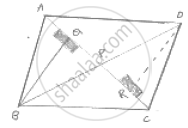Advertisements
Advertisements
प्रश्न
Diagonals AC and BD of a quadrilateral ABCD intersect each other at P. Show that:
ar(ΔAPB) × ar(ΔCPD) = ar(ΔAPD) × ar (ΔBPC)
उत्तर

Construction: Draw BQ ⊥ AC and DR ⊥ AC
Proof:
L.H.S
= ar (Δ APB ) × ar (ΔCP)
= `1/2[ ( AP xx BQ )] xx (1/2 xx PC xx DR)`
=`( 1/2 xx PC xx BQ )xx (1/2 xx AP xx DR)`
= ar (Δ BPC ) × ar (APR)
= RHS
∴ LHS = RHS
Hence proved.
APPEARS IN
संबंधित प्रश्न
If ABCD is a parallelogram, then prove that
𝑎𝑟 (Δ𝐴𝐵𝐷) = 𝑎𝑟 (Δ𝐵𝐶𝐷) = 𝑎𝑟 (Δ𝐴𝐵𝐶) = 𝑎𝑟 (Δ𝐴𝐶𝐷) = `1/2` 𝑎𝑟 (||𝑔𝑚 𝐴𝐵𝐶𝐷) .
A triangle and a parallelogram are on the same base and between the same parallels. The ratio of the areas of triangle and parallelogram is
Length of a rectangle is 30 m and its breadth is 20 m. Find the increase in its area if its length is increased by 10 m and its breadth is doubled.
This stamp has an area of 4 square cm. Guess how many such stamps will cover this big rectangle.

If each square on this page is equal to 1 square meter of land, how much land will each of her children get? ________ square m
The amount of region enclosed by a plane closed figure is called its ______.
How will you decide? Discuss.
Find the area of the following figure by counting squares:

Find the area of the following figure by counting squares:

Find the area of the following figure by counting squares:

